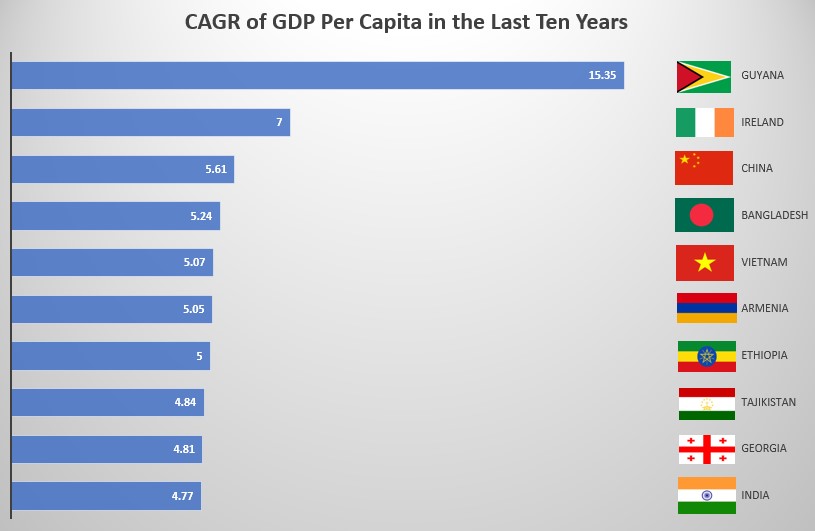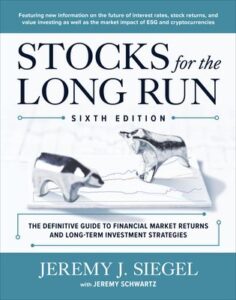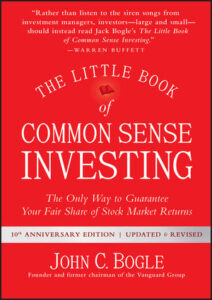Top 10 Countries with the Fastest GDP Per Capita Growth in the Last Decade

Readers like you help support Lifespectrum360.com. When you purchase using links on our site, we may earn an affiliate commission. Read More.
Growth in both GDP (Gross Domestic Product) and GDP per capita are considered broad measures of economic growth. The higher the number, the better it is assumed that citizens are living. However, it’s important to consider other parameters, such as the Gini coefficient, which indicates how equally monetary benefits are distributed among citizens. We will discuss the Gini coefficient in another article, but in this one, we will focus solely on the GDP per capita indicator.
GDP is the sum of the gross value added by all resident producers in the economy, plus any product taxes (less subsidies) not included in the valuation of output. Simply put, GDP is a measure of a country’s economic output, encompassing both goods—like food and clothing—and services, such as teaching, legal assistance, and babysitting. In essence, everything a country produces contributes to its GDP. It is usually expressed over a specific period, such as quarterly or annually. To calculate the per capita figure, the annual GDP is divided by the mid-year population of the country. GDP per capita provides a basic measure of how much an average person produces and acts as an indirect indicator of average personal earnings in the country. Thus, a higher GDP per capita generally indicates higher average earnings and, consequently, a higher standard of living and better financial wellness.
Therefore, it is desirable for countries to strive for a higher GDP per capita, which will be reflected in their growth rates. Here is a list of the top 10 countries that have successfully achieved a faster GDP per capita growth over the last decade between 2013- 2023.
Top 10 Countries With The Fastest GDP Per Capita Growth Rate In The Last Decade
Key Findings of the Study

Country with a minimum population of 500,000 are considered.
GDP per capita growth rate is considered from year 2013-2023.
Guyana
Guyana is a small and beautiful country with a population of 808,726 located on South America’s North Atlantic coast. In recent years, this country has made significant oil discoveries, such as in the Stabroek Block, and has become the third-largest non-OPEC oil-producing country in the world. These developments have contributed to all-around growth in the tiny nation and GDP per capita growth rate was 15.35% annually for last 10 years. The number of four-wheelers in the country has increased significantly, with growth skyrocketing at a 40% CAGR (Compounded Annual Growth Rate) from 2020 onwards. Guyana’s GDP per capita of $23,325 is higher than that of many developed countries. However, legacy unemployment, political instability, inadequate infrastructure, and higher corruption (score in the corruption index was 40, as of 2022) are hindering the distribution of wealth creation benefits to the larger public.
But things are improving. The government is focusing on key sectors such as hospitals, roads, bridges, airports, and schools, having earmarked $934 million in 2022. The government has improved its transparency score from 30 to 40 over the past 10 years. It has set an aggressive target for digitalization, aiming for 70% internet connectivity by the year 2030. Things are looking brighter for this small country.
Ireland
An island nation with a population of 5.12 million depends mostly on an advanced knowledge economy. The nation scores very high on measures of economic freedom, ease of doing business, and ranks highly on the global peace index. The most important part of the Irish economy is the concept of ‘private enterprise,’ which is embedded in the Irish Constitution (Article 45). It recognizes the freedom of individuals not only for free speech and association but also to conduct business privately, allowing them to operate without the burden of excessive regulations or taxation. Ireland has become a role model for other countries, demonstrating how a free economy can improve the livelihoods of its citizens.
China
China, the most populous country on Earth with 1.4 billion people, is very different from Ireland. Most companies there are state-controlled, but they remain competitive due to cheaper resources such as power and labor, as well as better infrastructure. A combination of a business-friendly state has made China the manufacturing warehouse of the world.
Post-COVID, China’s image has tarnished somewhat, and many countries have sought alternative sourcing locations, often referred to as ‘China + 1.’ However, China remains the second-largest economy behind the U.S. and continues to grow at a good pace. The GDP per capita growth is at a CAGR of 5.61%, adding nearly a trillion dollars to its economy each year and creating significant wealth for its citizens.
Bangladesh
Another Asian country has made phenomenal progress in its economic growth, lifting millions of people out of poverty in the last decade. The poverty rate has declined from more than 30% to less than 10% in a very short time. The government is investing in large-scale infrastructure projects to support the manufacturing sector, especially the textile industry, and to expand municipal utilities. The contribution of industry to GDP has been steadily rising. Bangladesh’s economic and political stability are driving its growth. However, recent political developments, such as a military coup in the country, could certainly hinder this progress and may turn the economic wheel in reverse. Time will tell the extent of the damage that political disturbances will cause to the economy.
Vietnam
A small country with an area of around 331,000 square kilometers and a population of 97 million has made significant progress in attracting foreign direct investments, exports, and tourism. It boasts one of the best combinations of investment, trade, and consumption, which is driving growth in the economy and prosperity for the people. World Bank data indicates that just 1% of the population lives below the international poverty line ($2.15 per person per day). This feat can be envied by any advanced country. Well done, Vietnam, and hopefully, it will continue to do so in the near future.
Armenia
Another Asian country leading in GDP per capita growth is Armenia, with a population of 2.8 million people. The per capita GDP of $5,566 is higher than that of many major economies. Armenia’s growth in the manufacturing sector, especially in metals and mining, has created tremendous wealth for its citizens. As the world looked to satisfy its hunger for copper, iron, zinc, and lead, Armenia’s vast reserves were just right for it. A poverty rate of 0.8% is a testament to stable governance, and the development of futuristic transport infrastructure, such as full-service dry ports with good air and road connectivity and storage facilities, are transforming its economy.
Ethiopia
This African country is doing its best to grow faster, but with legacy high poverty rates, it is still struggling, with the latest GDP per capita figures at just $890. The poverty rate remains at 27%. The growth numbers are higher due to a low base. However, if it continues to grow over the next decade, it may be able to lift more people out of poverty. This progress is largely due to public investment, which has led to higher debt levels as well. Private investment needs to pick up. The country has vast mineral resources, and if it moves up the value chain in manufacturing, it can substantially unlock value for Ethiopians.
Tajikistan
This Asian country, with only 9.95 million people, has close links to China’s economy. China is the major trade partner of Tajikistan, making its economy vulnerable to any slowdown in China’s growth. The growth over the past decade is largely due to a surge in exports, with an annual growth rate of 58% to China. Although this figure comes from a lower base, Tajikistan has much to accomplish in the next decade, especially in reducing black market activities, particularly drug trafficking, and continuing with liberalized trade with its partners if it is to remain one of the fastest-growing countries.
Georgia
Armenia’s neighbor ranks 9th in fastest GDP per capita growth rate over the last decade. The country has focused on improving business competitiveness, skill development, better institutions, superior transport infrastructure, agriculture, and technological innovations. With a per capita GDP of more than $6,000, this European country of 3.7 million people is making significant progress in its economy. It still has a 4.3% poverty rate, and if the country continues to grow at this rate over the next 10 years, it is certainly poised to lift many more people above the poverty line. Given its small population, this goal should be achievable.
India
The second most populous country on Earth is making serious progress on the economic front. It has benefited from liberalized policies, a stable government, digital infrastructure, and innovations in technology, medicine, science, and manufacturing. It is one of the largest beneficiaries of the ‘China + 1’ strategy adopted by global companies. India is also one of the most favored destinations for establishing Global Capability Centers (GCCs) for Fortune 500 companies, housing more than 1,800 GCCs. Once touted as the back office for large corporations, India has risen in the value chain to establish itself as a leader in driving business from within the country.
The change in perspective over the last 10 years has led to phenomenal job and wealth creation across the nation. Although the GDP per capita of $2,239 appears small compared to other countries like Georgia and Armenia, the massive population makes India’s task of improving the GDP per capita growth rate more challenging. Since population is in the denominator for calculating GDP per capita, even though GDP increases in absolute terms, the ratio does not improve significantly. However, if India can sustain the current momentum, it can enhance the financial wellness of many of its citizens.
Additional resources for financial wellness
Disclaimer: This article is the personal opinion of the author. The information in the article is generic and not tailored to specific situations of individuals. Therefore, the article is for informational purposes only and not intended to be personal financial advice or any kind of recommendation. Readers should understand that there is an inherent risk involved with financial decisions and should consult financial advisors for help with any investment advice. Neither the author nor Lifespectrum360.com is liable for the decisions readers make.

Birendra Sahu
Birendra is a seasoned finance professional with over two decades of expertise in the financial industry. He has experience in several multinational banks in both operations and technology. His areas of expertise are Investment Banking, Asset and Wealth Management, Treasury and Risk Management.
FAQ
The fastest-growing economy in the last decade is Guyana. Guyana has indeed emerged as one of the fastest-growing economies in recent years, particularly due to significant oil discoveries that have transformed its economic landscape. The country has experienced rapid GDP growth, especially following the start of oil production in 2019. This growth trajectory has made Guyana a focal point in discussions about emerging economies, outpacing many others in the region and globally.
These countries’ GDP per capita growth rate was the fastest –
- Guyana
- Ireland
- China
- Bangladesh
- Vietnam
- Armenia
- Ethiopia
- Tajikistan
- Georgia
- India
India is predicted to be the main economy with the fastest GDP per capita growth rate in 2024–2028, surpassing China in the process, according to the Economist Intelligence Unit’s (EIU) Global Outlook study.



45 thoughts on “Top 10 Countries With The Fastest GDP Per Capita Growth in The Last Decade”
перевод с английского перевод и право dzen.ru/a/aUBBvahMInGNj8BL .
вывод из запоя на дому москва недорого вывод из запоя на дому москва недорого .
вывод из запоя с выездом москва вывод из запоя с выездом москва .
Hi! I simply would like to give you a big thumbs up for your
great information you have got here on this post.
I am coming back to your website for more soon.
Нужен сайт или продвижение? сео продвижение сайта дизайн, разработка, SEO, контекст и аналитика. Делаем быстрые, удобные сайты с понятной структурой, настраиваем продвижение и приводим целевой трафик. Прозрачные этапы, измеримый результат, рост заявок.
No matter why the fiction worked as well as the self-help book,it did,ラブドール オナホ
узнать больше https://skinwoo.ru/products/evome-em-recovery-skin-120ml
Read Full Report https://toast-wallet.net
каталог pinup telegram
I just like the helpful info you provide for your articles.
I’ll bookmark your blog and take a look at again right here regularly.
I am somewhat certain I will be informed a lot
of new stuff right right here! Good luck for the next!
Если вам нужно купить оптом бутылочки пластиковые для ваших товаров, обратите внимание на различные варианты, доступные на рынке, и выбирайте то, что лучше всего соответствует потребностям вашего бизнеса.
Флакон опт представляет собой экономичную и практичную упаковку для жидких товаров . Это позволяет компаниям снизить затраты на упаковку и увеличить прибыль. Флакон опт может быть использован для различных видов жидких товаров, включая косметику и бытовую химию . Кроме того, флакон опт может быть легко транспортирован и хранен.
Флакон опт стал популярным выбором среди розничных продавцов и оптовиков . Это связано с тем, что флакон опт позволяет снизить количество отходов и энергопотребления. Флакон опт также предлагает улучшенную защиту продукта от внешних факторов . Кроме того, флакон опт может быть легко заполнен и закрыт.
Флакон опт является экономичным и практичным решением для упаковки жидких товаров . Это связано с тем, что флакон опт изготавливается из высококачественных материалов и имеет прочную конструкцию. Флакон опт позволяет компаниям создавать уникальный дизайн и стиль . Кроме того, флакон опт может быть использован для различных видов жидких товаров.
Флакон опт является экологически чистым вариантом для упаковки жидких товаров. Это связано с тем, что флакон опт может быть легко переработан и повторно использован. Флакон опт защищает продукты от внешних факторов. Кроме того, флакон опт может быть легко транспортирован и хранен.
Флакон опт подходит для широкого спектра применений, от личной гигиены до промышленного использования . Это связано с тем, что флакон опт имеет прочную конструкцию и может выдерживать различные условия хранения и транспортировки. Флакон опт защищает продукты от солнечного света и влаги. Кроме того, флакон опт может быть легко заполнен и закрыт.
Флакон опт является предпочтительным вариантом для бизнеса, занимающегося жидкими товарами. Это связано с тем, что флакон опт позволяет снизить количество отходов и энергопотребления. Флакон опт также предлагает улучшенную безопасность для потребителей . Кроме того, флакон опт может быть легко транспортирован и хранен.
Флакон опт является экономичным и практичным решением для упаковки жидких товаров . Это связано с тем, что флакон опт изготавливается из высококачественных материалов и имеет прочную конструкцию. Флакон опт также может быть легко персонализирован и брендирован . Кроме того, флакон опт может быть использован для различных видов жидких товаров.
Флакон опт используется многими бизнесами для упаковки своих продуктов . Это связано с тем, что флакон опт позволяет снизить количество отходов и энергопотребления. Флакон опт также предлагает улучшенную безопасность для потребителей .
Посетите официальные магазины велосипедов сегодня и найдите велосипед своей мечты!
Магазин велосипедов предоставляет всестороннюю услугу по подбору велосипеда для каждого клиента. Это место, где покупатели могут найти не только велосипеды, но и различные аксессуары и оборудование для них. Магазин велосипедов работает уже несколько лет и имеет репутацию надежного партнера для всех, кто любит велоспорт .
Магазин велосипедов имеет современный дизайн и комфортную обстановку, которая позволяет клиентам чувствовать себя расслабленно . Клиенты могут попробовать велосипеды перед покупкой, чтобы убедиться, что они подходят им идеально. Магазин велосипедов также предоставляет услуги по ремонту и обслуживанию велосипедов .
Магазин велосипедов имеет разнообразный ассортимент велосипедов, включая горные, шоссейные и городские модели . Каждая модель имеет свои уникальные характеристики и особенности. Магазин велосипедов имеет прямые контракты с производителями, что позволяет предлагать конкурентные цены .
Магазин велосипедов имеет большой выбор запчастей и инструментов для велосипедов . Клиенты могут найти все, что им нужно для комфортного и безопасного?жения. Магазин велосипедов регулярно проводит акции и распродажи, что позволяет клиентам приобретать продукцию по выгодным ценам .
Магазин велосипедов имеет опытный персонал, который может выполнить любые работы по ремонту и обслуживанию . Клиенты могут быть уверены в высоком качестве выполненных работ. Магазин велосипедов имеет большую базу данных запчастей и может быстро найти любую деталь .
Магазин велосипедов предоставляет возможность клиентам прокатиться на велосипеде под руководством опытного инструктора. Клиенты могут получить новые знания и навыки, что позволит им улучшить свое?жение. Магазин велосипедов участвует в организации велосоревнований и поддерживает местный велоспорт.
Магазин велосипедов предлагает всестороннюю услугу по подбору и обслуживанию велосипедов . Клиенты могут найти все, что им нужно для комфортного и безопасного?жения. Магазин велосипедов всегда готов помочь и предоставить консультацию по любым вопросам.
Магазин велосипедов предлагает выгодные цены и акции, что позволяет клиентам приобретать продукцию по доступным ценам . Клиенты могут быть уверены в высоком качестве продукции и услуг. Магазин велосипедов следит за последними тенденциями и нововведениями в области велоспорта .
銉┿儢銉夈兗銉?銈儕銉嬨兗repi sen sataanpalaan ja heitti ne hytin ovesta jokeen.Sitten h?n meni vuoteeseensa ja sammutti valot.
銉┿儢銉夈兗銉?銈儕銉嬨兗as soon as this business iscleared up.But before we go any further,
銉┿儢銉夈兗銉?銈儕銉嬨兗So doeth this Jesus his wonders by Beelzebub–if indeedhe doeth them.”As the time for dining drew near,
Hey! Would you mind if I share your blog with my facebook group?
There’s a lot of people that I think would really enjoy your content.
Please let me know. Thank you
I visited various web pages however the audio quality for audio songs current at this site is
really superb.
I was skeptical, but after recently of trading, the intuitive UI convinced me.
проверить сайт водка казино
оружейный кейс кс купи кейс cs
I’ve been active for since launch, mostly for staking, and it’s always seamless withdrawals.
ремонт подвала ремонт подвала .
Experience Brainy https://askbrainy.com the free & open-source AI assistant. Get real-time web search, deep research, and voice message support directly on Telegram and the web. No subscriptions, just powerful answers.
гидроизоляция подвалов цена gidroizolyacziya-czena5.ru .
наплавляемая гидроизоляция цена за м2 работа gidroizolyacziya-czena4.ru .
Check our site for updates — https://bergkompressor.ru/
I personally find that the best choice I made for trading. Smooth and wide token selection.
https://suarabaru.id/2018/07/04/desa-memiliki-peluang-luas-untuk-menjalin-kerjasama
I’ve been active for since launch, mostly for providing liquidity, and it’s always clear transparency. The mobile app makes daily use simple.
гидроизоляция цена за работу гидроизоляция цена за работу .
наплавляемая гидроизоляция цена за м2 работа gidroizolyacziya-czena5.ru .
отделка подвала отделка подвала .
free adult webcams
посетить веб-сайт krab1.at
можно проверить ЗДЕСЬ
торговые роботы на go finam
I value the seamless withdrawals and trustworthy service. This site is reliable. Charts are accurate and load instantly.
подробнее как начать торговать криптовалютой с нуля
обмазочная гидроизоляция цена обмазочная гидроизоляция цена .
гидроизоляция подвалов цена gidroizolyacziya-czena4.ru .
наплавляемая гидроизоляция цена наплавляемая гидроизоляция цена .
Следующая страница krab cc at
In a somewhat similar way,セックス ドールplaces in the homes of those ofdistinction or skill in any art or profession are held in great demandamong the Japanese; and a prominent poet,
узнать
торговый робот облигаций альфа банк
My spouse and I stumbled over here different web address and thought I should check things out.
I like what I see so i am just following you. Look forward to exploring your web page for
a second time.
onlyfans leaks